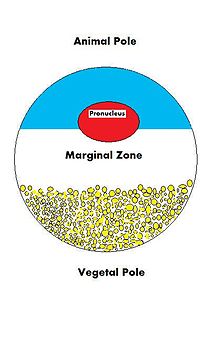Polarity in embryogenesis
This article needs additional citations for verification. (October 2006) |

In developmental biology, an embryo is divided into two hemispheres: the animal pole and the vegetal pole within a blastula.
The animal pole consists of small cells that divide rapidly, in contrast with the vegetal pole below it. The animal pole draws its name from its liveliness relative to the slowly developing vegetal pole. In some cases, the animal pole is thought to differentiate into the later embryo itself, forming the three primary germ layers and participating in gastrulation. Sperm enters the egg at the vegetal pole.[1]
The vegetal pole contains large yolky cells that divide very slowly, in contrast with the animal pole above it. The vegetal pole draws its name from its inactivity relative to the lively animal pole. In some cases, the vegetal pole is thought to differentiate into the extraembryonic membranes that protect and nourish the developing embryo, such as the placenta in mammals and the chorion in birds.
In the frog Xenopus laevis, a pigment pattern provides the oocyte with features of a radially symmetrical body with a distinct polarity. The animal hemisphere is dark brown, and the vegetal hemisphere is only weakly pigmented. The axis of symmetry passes through on one side the animal pole, and on the other side the vegetal pole. The two hemispheres are separated by an unpigmented equatorial belt. Polarity has a major influence on the mergence of the embryonic structures. In fact, the axis polarity serves as one coordinate of geometrical system in which early embryogenesis is organised.[2]
References
See also
